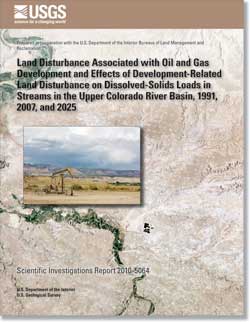 Abstract Abstract
Oil and gas resource development in the Upper Colorado River Basin (UCRB) has increased substantially since the year 2000. The UCRB encompasses several significant oil and gas producing areas that have the potential for continued oil and gas resource development. Land disturbance associated with oil and gas resource development is caused by activities related to constructing drill pads to contain drilling and well maintenance equipment and roads to access the drill pad. Land disturbed by oil and gas development has the potential to cause increased erosion, stream degradation, habitat fragmentation and alteration, and increase public use of areas that may be environmentally sensitive. Land disturbance resulting from oil and gas resource development has not been monitored and mapped on a regional scale in the UCRB. However, information on the location and age of oil and gas wells in the UCRB is available. These data combined with geographic data analysis and modeling techniques were used to estimate the total area of disturbed land associated with oil and gas resource development in 1991 and in 2007 in the UCRB. Additional information about anticipated oil and gas development in the UCRB was used to project land disturbance to the year 2025. Results of the analysis indicate that approximately 117,500 acres (183 mi2) of total land disturbance was associated with drill pads and related roads in the UCRB in 1991. The estimated area of disturbed land associated with oil and gas development increased 53 percent to 179,400 acres (280 mi2) in 2007. Projecting oil and gas development through 2025 results in a potential near doubling of the land surface disturbance to approximately 319,300 acres (500 mi2).
Estimated land disturbance for 1991 and 2007 were input to a contaminant transport model developed for the UCRB to assess the statistical significance of energy-related land disturbance to contributing dissolved solids to basin streams. The statistical assessment was an observational study based on an existing model and available water-quality monitoring data for the basin. No new data were collected for the analysis. The source coefficient calibrated for the disturbed lands associated with oil and gas development in 2007 was zero, which indicated that estimated land disturbance from oil and gas development is not statistically significant in explaining dissolved solids in UCRB streams. The lack of significance in the contaminant transport modeling framework may be due to the amount of available monitoring data, the spatial distribution of monitoring sites with respect to land disturbance, or the overall quantity of land disturbance associated with oil and gas development basin wide. Finally, dissolved-solids loads derived from natural landscapes may be similar to loads derived from lands disturbed by oil and gas resource development. The model recalibration done for this study confirms calibration results from Kenney and others (2009): the most significant contributor to dissolved solids in the UCRB is irrigated agricultural land, which covers an area substantially larger than the estimated area disturbed by oil and gas development and is subjected to artificially applied water.
|
First posted June 11, 2010
Part or all of this report is presented in Portable Document Format (PDF); the latest version of Adobe Reader or similar software is required to view it. Download the latest version of Adobe Reader, free of charge. |